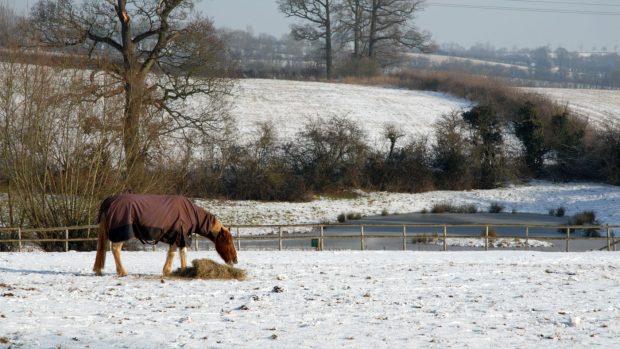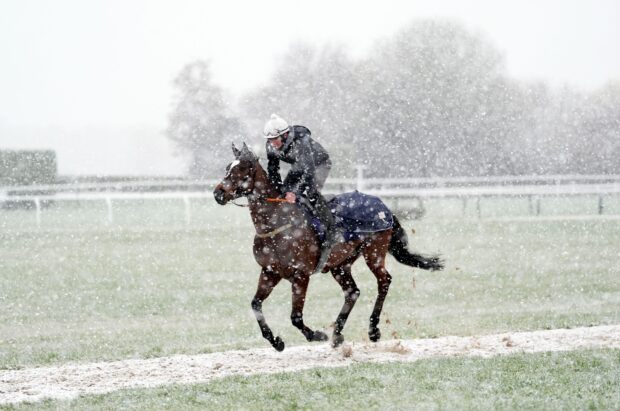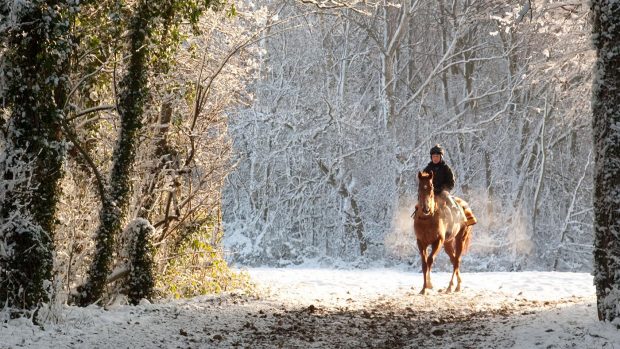Usually each winter, the UK is covered with snow and ice at some point, and riders tend to give their horses time off work or keep them in stables if it is too icy for turn-out.
Steel shoes are lethally slippery on ice, and snow sticks to the metal, building up into snowballs so it looks like the horse is on stilts, which can cause the horse to trip and injure itself.
Yet many other places in the world are covered with snow and ice through much of the winter, and still, people keep on riding. H&H investigates how…
Amy Feineman, a trainer in Colorado, told us that all her horses go barefoot in the winter.
“They shed snow best that way,” she explained. “Our farrier even took pads off my one shod horse to give her better snow clearing.”
Barefoot horses don’t get snowballs, which makes sense if you think of mustangs in the snowy American west, or Przewalski’s horses in Mongolia.
However, not every horse can go barefoot and not every rider wants to. And while unshod horses don’t accumulate snowballs, barefoot provides very little traction on ice.
The western states like Colorado don’t get long term accumulations of ice on roads and paths, but the states in the Midwest and on the East Coast often do.
Chelsea Shield-Mas, a dressage rider in New York, said: “I use ice studs in New York — no snow pads as my horse has bar shoes behind and my farrier was concerned about pads being paired with those shoes.”
There are two different types of pads. One is a pad that covers the entire sole of the hoof, with a ball in the middle, often called a bubble pad. It is the most effective pad for getting rid of snowballs, but as with any full pad, it increases the risk of thrush because it prevents the exposure of the sole to the air and traps mud and dirt underneath.
When I lived in the United States, I used rim pads, a rubber tube riveted between the horseshoe and the foot that went round the edge of the shoe. According to The American Farrier’s Journal: “A full pad of any kind will eventually fill up with mud or sand, but the rim style No-Sno pad will leave the bottom of the hoof open and keep the hoof healthy. This pad will not have any negative effect in muddy conditions but will still be there when it snows again.”
The tube of the rim pad, combined with the frog, pushes the snow out of the hoof. The downside is that it’s not as effective at getting rid of snowballs as the bubble pads.
Jenna Calcaterra, a Virginia-based eventer who used to live in Massachusetts, preferred the full pads, saying: “The rim pads always got snow wedged under them.”
Rim pads and bubble pads provide some traction on snow, but where there is hard ice, you need studs of some sort. The most commonly used is borium, a substance containing hard steel which the farrier welds to the shoe. It impedes the natural lateral rotation of the limb on hard, dry surfaces, which can lead to lameness, so it’s best used in places where the snow and ice is likely to stick around for the majority of the winter.
Similarly, some riders and farriers opt for snow and ice nails, which are more or less normal horse shoe nails, but they extend beyond the plane of the shoe and have a hardened head. If all you’re doing is walking from the yard to the indoor arena or paddock, this may be enough. However, like any horseshoe nail, they wear out before the end of the shoeing cycle, and someone spending a lot of time hacking will find borium longer lasting.
Another option are screw-in studs, like the ones eventers and showjumpers use. These can (and should) be removed when the horse isn’t ridden or if it’s being ridden indoors but can be added if the rider knows they’re crossing icy ground. It means the horse doesn’t wear a traction device when it doesn’t need to, which is healthier for its limbs (and for its turn-out companions), but it requires the rider to take time maintaining the holes and screwing in the studs.
Shoeing horses for traction on ice isn’t entirely foreign to the UK. In the winter of 1788, the poet Robert Burns was riding through Wanlockhead, a village that sits at 467m of altitude in the Southern Uplands of Scotland, and found his horse sliding on the ice. Burns tried to persuade John Taylor, “man of influence” in the village, to convince the local farrier to add caulks to his horse’s shoes so Burns could ride instead of walk. In payment for his assistance, Burns wrote Taylor this poem:
With Pegasus upon a day, Apollo, weary flying,
Through frosty hills the journey lay, On foot the way was plying.
Poor slipshod giddy Pegasus Was but a sorry walker;
To Vulcan then Apollo goes, To get a frosty caulker.
Obliging Vulcan fell to work, Threw by his coat and bonnet,
And did Sol’s business in a crack; Sol paid him with a sonnet.
Ye Vulcan’s sons of Wanlockhead, Pity my sad disaster;
My Pegasus is poorly shod, I’ll pay you like my master.
H&H recommends that you communicate with your farrier to find the method that best suits your horse or pony.
You might also enjoy reading…

16 things that only people with horses know about snow

Subscribe to Horse & Hound magazine today – and enjoy unlimited website access all year round
Horse & Hound magazine, out every Thursday, is packed with all the latest news and reports, as well as interviews, specials, nostalgia, vet and training advice. Find how you can enjoy the magazine delivered to your door every week, plus options to upgrade your subscription to access our online service that brings you breaking news and reports as well as other benefits.





